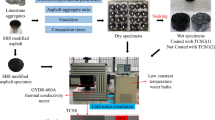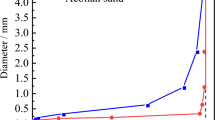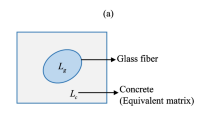Abstract
The addition of graphite powder in conventional asphalt mixture can produced asphalt concrete with excellent electrical performance. Percolation theory was employed to discuss the relation between the conductivity and graphite content of graphite-modified asphalt concrete. It was found that the results of percolation model are consistent with experimental values. The percolation threshold of graphite-modified asphalt concrete is 10.94% graphite content account for the total volume of the binder phase consisting of asphalt and graphite. The critical exponent is 3.16, beyond the range of 1.6–2.1 for the standard lattice continuous percolation problem. Its reason is that the tunnel conduction mechanism originates near the critical percent content, which causes this system to be not universal. Tunnel mechanism is demonstrated by the nonlinear voltage-current characteristic near percolation threshold. The percolation model is able to well predict the formation and development of conductive network in graphite-modified asphalt concrete.
Similar content being viewed by others
References
Wu Shaopeng, Mo Liantong, Shui Zhonghe An Improvement of Electrical Properties of Asphalt Concrete.Journal of Wuhan University of Technology-Mater. Sci. Ed., 2002, 17(4):69–72
Wu S P, Mo L T, Shui Z H. Piezoresistivity of Graphite Modified Asphalt-based Composites.Key Engineering Materials, 2002, 249:391–396
Nan C W. Physics of Inhomogeneous Inorganic Materials.Progress in Materials Science, 1993, 37:1–116
Nan Cewen, Chen Xinzheng. Percolation Model of Ti−Al2O3 cement.ACTA Phys. SINICA, 1987, 36:511–514
Grimaldi C, Maeder T, Ryser P, Strassler S. Segregated Tunneling-percolation Model for Transport Nonuniversality.Phys. Reiv. B, 2003, 68 (2):2420–2427
Xue Q Z. A Percolation Model of Metal-insulator Composites.Phys. B-Condensed Material, 2003, 325 (1–4):195–198
Kandhal P S, Cooley L A. Coarse-versus Fine-graded Superpave Mixtures.Transportation research Record, 2002, (1789):216–224
Yildirim Y, Solaimanian M, McGennis R B. Comparative analysis of Volumetric Properties for Superpave Gyratory Compactors.Transportation research Record, 2002, (1712):44–52
Ezquerra T A, Connor M T, Roy S. Alternating-current Properties of Graphite, Carbon-black and Carbon-fiber Polymeric Composites.Composites Science and Technology, 2001, 61: 903–1001
Guohua Chen, Wengui Wen, Dajun Wu, Cuiling Wu. Nonlinear Conduction in Nylon-6/Foliated Graphite Nanocomposites above the Percolation Threshold.Journal of Polymer Science, Part B: Polymer Physics, 2004, 42:155–162
Author information
Authors and Affiliations
Corresponding author
Additional information
Funded by the Outstanding, Youth Foundation of Hubei Province of China (No.2004ABB019)
Rights and permissions
About this article
Cite this article
Liantong, M., Shaopeng, W., Xiaoming, L. et al. Percolation model of graphite-modified asphalt concrete. J. Wuhan Univ. Technol.-Mat. Sci. Edit. 20, 111–113 (2005). https://doi.org/10.1007/BF02870889
Received:
Accepted:
Issue Date:
DOI: https://doi.org/10.1007/BF02870889




